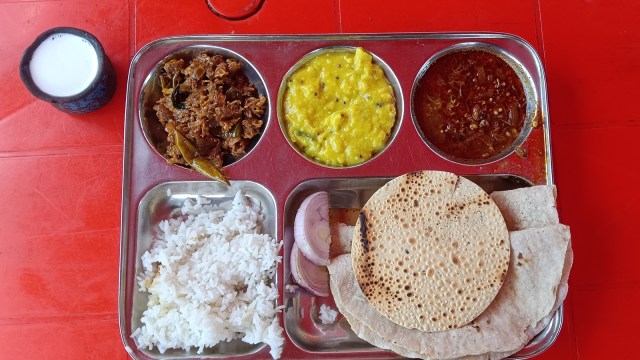Click here to join Express Pune WhatsApp channel and get a curated list of our stories
Pune on My Plate: From the food of soldiers to the taste of Pune, why ‘pithla-bhakri’ atop the iconic Sinhagad fort is an unmissable experience
Once, the hills of Sinhagad Fort had echoed with the clash of swords during the time of Chhatrapati Shivaji Maharaj. Centuries later, it continues to be the most popular spot in Pune, where hundreds come to feel the valour and savour the spirit of traditional Maharashtrian dishes from the eateries.
 Once a soldier’s meal, today it’s a taste of home, heritage, and the fort’s living history. (Express Photo)
Once a soldier’s meal, today it’s a taste of home, heritage, and the fort’s living history. (Express Photo)Written by Ruta Patil
After the mist clears and the sun reaches the fort walls, Sinhagad is filled with the aroma of garlic, chillies, and besan. At the top, small eateries come alive, with bhakris (a kind of bread) puffing on tavas, pithla bubbling, and the hiss of oil mingling with the sound of laughter. Plates clatter, buttermilk froths, and the fort hums with the flavours.
Once, these hills had echoed with the clash of swords when Tanaji Malusare, the military commander of the erstwhile Maratha kingdom, fought bravely to win the fort for Chhatrapati Shivaji Maharaj. Centuries later, it continues to be the most popular spot in Pune, where hundreds come to feel the valour and savour the spirit of traditional Maharashtrian dishes from the eateries.
The soul of Sinhagad: pithla and bhakri
At Sinhagad, pithla-bhakri isn’t just a meal, it is its soul. Every morning, women climb its slopes, carrying baskets of flour, curd, and vegetables on their heads to feed people with love and turn the fort’s legacy of strength into one of nourishment and warmth.
 Laughter, chatter, and the clatter of steel plates.Each bite of pithla bhakri carries the fort’s warmth, its history, and the love of those who make it. (Express Photo)
Laughter, chatter, and the clatter of steel plates.Each bite of pithla bhakri carries the fort’s warmth, its history, and the love of those who make it. (Express Photo)
“So many people come here just to have food, pithla-bhakri, matki usal, bharit, thecha, they love it all,” says Vandana Shinde, who has been cooking at the fort for over 25 years. “Earlier, we made everything on wood fires. Now we use stoves, but the love and taste remain the same.”
The thali that arrives at your table is a mound of golden pithla, soft yet spicy, sitting beside a perfectly charred bhakri. A smoky vangyache bharit — mashed brinjal tempered with onion and spices — and at its side lies a handful of zanzanit matki usal; along with it, you are served a fiery red thecha that demands courage, and a bowl of cool, thick curd to balance it all. If you’re lucky, a glass of Maharashtrian butter milk called tak follows — light, salty, and perfect after the climb.
Simple, authentic, unforgettable experience
“‘Sinhagad Pithla Bhakri’, the term itself comprises everything, the love that these people put in their food, it is so simple and authentic, I think that is what makes it so special. We come here for our daughter, she loves the food here,” says Archana Navathe, who’s been visiting for 34 years. Her daughter Yadnyee, visiting from Italy, laughs, “If I could, I would eat this food every day. So much love, and on top of that, the dahi and tak! I make it a point to have at least three to four matkifuls of dahi sakhar.”
 After the long trek up Sinhagad, a plate of hot, crispy bhajis and a glass of chilled taak with the view become the silent celebration of the climb. (Express Photo)
After the long trek up Sinhagad, a plate of hot, crispy bhajis and a glass of chilled taak with the view become the silent celebration of the climb. (Express Photo)
And when you just want a quick bite, the hot and fresh bhajis with onion and potato, dipped in gram flour batter and fried golden, will be ready in an instant. “The bhajis here are a delight, crispy, flavourful, and best enjoyed with the view and friends,” says Nandakishore Parikh, a regular visitor from Rajasthan.
A serving that holds history
The dish itself tells the story of endurance. Pithla-bhakri was once a soldier’s food, quick to cook, rich in protein, made from simple ingredients that lasted through long campaigns. “It reminds me of the time when our Mavalas, Shivaji Maharaj’s soldiers, survived on this same meal,” says Nilesh Bhosale, a Pune businessman. “It’s simple but full of strength.”
 Every morning, women climb the fort with sacks of flour, curd, and vegetables on their head,making sure that every visitor is fed with love and care. (Express Photo)
Every morning, women climb the fort with sacks of flour, curd, and vegetables on their head,making sure that every visitor is fed with love and care. (Express Photo)
Every serving here carries a history of its own. “My mother used to serve food straight on the hand, a hot bhakri with pithla on top,” recalls Ganga Waghmare, whose family has fed visitors for four decades. “Even at midnight, trekkers would come hungry, and we’d serve them by the fire.”
The fort stands as a monument to courage, its strength now lying in the hands of the ones who cook, serve, and feed. At Sinhagad, history is not just remembered; it’s eaten, shared, and savoured, one plate of pithla bhakri at a time.
(Ruta Patil is an intern with The Indian Express)
Click here to join Express Pune WhatsApp channel and get a curated list of our stories







